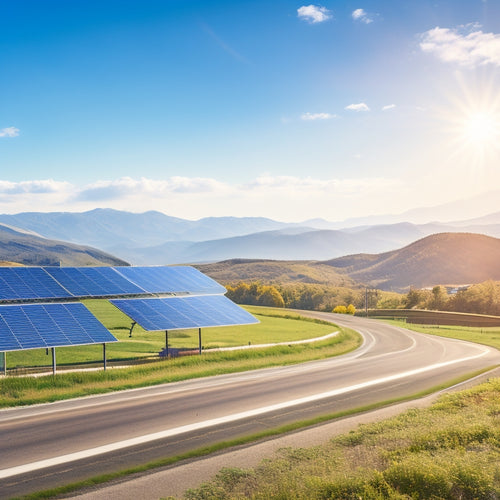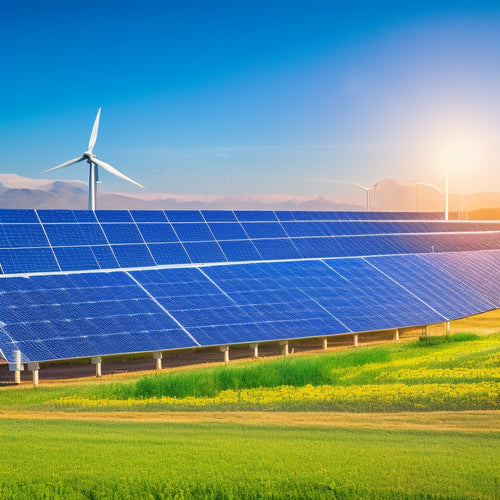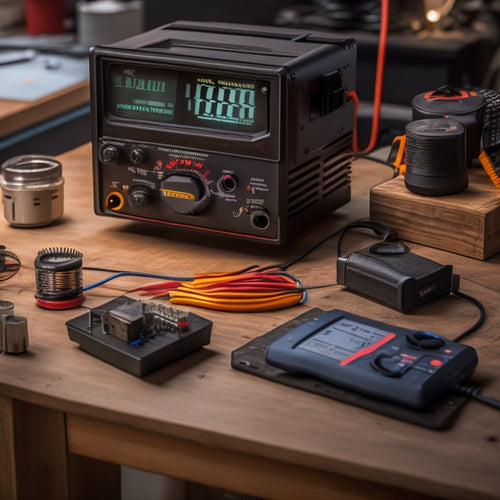
Clean Frame Secrets for Efficient Energy Harvesting
Share
You can optimize your energy harvesting system's performance by up to 30% by applying clean frame secrets that maximize power conversion rates, minimize energy losses, and guarantee durability in harsh environments. Focus on achieving a higher energy conversion rate through effective power management, load matching, and impedance matching. Durability is also vital, so select materials that can withstand extreme temperatures, humidity, and physical stress. Additionally, surface engineering techniques like nanostructured patterns can enhance energy absorption. By leveraging these secrets, you'll be well on your way to revealing efficient energy harvesting - and uncovering more innovative strategies that will take your system to the next level.
At a Glance
- Achieving a higher energy conversion rate is essential for maximizing energy harvesting performance, requiring a well-designed solar array and advanced technology.
- Load matching is critical to ensure maximum power transfer from the source to the load, enhancing efficiency and minimizing energy losses.
- Ideal energy transfer relies on impedance matching between the energy source and harvesting device, as well as minimizing parasitic losses in transmission lines.
- Weather-resistant coatings and rugged material selection are vital for energy harvesting systems in harsh environments, ensuring durability and reliability.
- Nanostructured surfaces and surface engineering can significantly boost energy harvesting efficiency by increasing surface area and enhancing energy absorption capabilities.
Higher Energy Conversion Rate
You're looking to maximize your energy harvesting setup's performance, and that means achieving a higher energy conversion rate. To get the most out of your system, you need to refine for maximum power output and ideal energy transfer.
By focusing on these key factors, you'll be able to squeeze every last bit of energy out of your setup. A well-designed Solar Array can address common issues of high upfront costs and inefficient energy conversion, allowing you to transition to a more sustainable energy source.
With advanced technology and user-friendly configurations, you can simplify the installation process and maximize your energy conversion rate.
Maximum Power Output
Maximum power output, a critical aspect of energy harvesting, hinges on optimizing the energy conversion rate. You need to verify that the maximum power available from the energy source is extracted and converted into usable electrical energy. This requires careful power management, as any inefficiencies in the conversion process can lead to considerable energy losses.
For instance, high-efficiency battery systems can notably improve energy conversion rates by reducing energy losses during storage and retrieval. Similarly, using advanced technologies like lithium-ion batteries can also enhance energy conversion efficiency.
To achieve maximum power output, you must match the load impedance to the source impedance, a process known as load matching. This guarantees that the maximum power is transferred from the source to the load, minimizing energy losses and maximizing efficiency.
Load matching is critical, as mismatched impedances can result in reduced power output, overheating, and even damage to the energy harvesting system.
Optimal Energy Transfer
Ideal energy transfer is vital for achieving a higher energy conversion rate in energy harvesting systems. As you design your system, you'll want to focus on refining energy transfer techniques to minimize losses and maximize output. This requires a profound comprehension of the underlying physics and a careful selection of materials and geometries.
By leveraging top-rated photovoltaic power storage solutions, such as Solar Battery for Solar Panels, you can guarantee that your energy harvesting system operates at peak efficiency. Additionally, understanding how to optimize energy transfer is essential for maximizing the usable capacity of your solar panels.
To achieve ideal energy transfer, you'll need to implement efficiency optimization strategies that address energy losses at every stage of the process. This may involve optimizing the impedance matching between the energy source and the harvesting device, reducing parasitic losses in the transmission lines, or developing novel energy transfer techniques that minimize energy dissipation.
Enhanced Durability in Harsh
You're likely aware that energy harvesting systems deployed in harsh environments face unique challenges.
By leveraging DIY solar panels and renewable energy setup, homeowners can guarantee a reliable source of power.
To secure reliable operation, you need to focus on weather-resistant coatings that can withstand extreme temperatures, humidity, and exposure to the elements off-grid power.
Weather Resistant Coatings Matter
In the pursuit of capturing energy from environmental sources, weather resistant coatings play an essential role in guaranteeing the durability of energy collection devices, especially in harsh conditions.
You must consider the type of coating that suits your device's specific needs. There are various coating types, including epoxy, polyurethane, and silicone-based coatings, each with its own strengths and weaknesses. For instance, epoxy coatings offer excellent chemical resistance, while polyurethane coatings provide flexibility and abrasion resistance.
When applying weather resistant coatings, you'll want to employ techniques that ascertain a strong bond between the coating and the device's surface. Some common application techniques include spraying, brushing, and roll-coating.
The chosen technique will depend on the device's design and the coating's viscosity. Additionally, surface preparation is vital, as it affects the coating's adhesion and overall performance.
Rugged Material Selection Key
Selecting rugged materials for your energy harvesting devices is essential to guaranteeing their reliability and performance in harsh environments.
You'll want to take into account material properties that can withstand extreme temperatures, humidity, and physical stress. For instance, materials with high tensile strength, corrosion resistance, and UV stability are ideal for outdoor applications.
When evaluating materials, don't forget to take into account their environmental impact. Look for materials with low embodied energy, recyclable, and locally sourced to minimize your carbon footprint.
Cost considerations are also vital, as you'll need to balance the material's performance with its manufacturing cost. Manufacturing techniques, such as 3D printing, can also impact the material's properties and cost.
Perform lifecycle analysis to assess the material's performance over its entire lifespan. This includes performance testing under various conditions to guarantee the material can withstand the rigors of its intended application.
Nanostructured Surface Boosts Efficiency
You'll find that surface roughness plays an essential role in energy harvesting, as it directly affects the interaction between the surface and the surrounding environment.
This is particularly important for off-grid cabin living, where rural homes rely heavily on renewable energy sources.
By introducing nanostructured patterns, you can greatly enhance the energy conversion efficiency.
Specifically, the strategic design of these patterns can increase the surface area, allowing for more efficient energy transfer.
Surface Roughness Matters
By precisely engineering surface roughness at the nanoscale, researchers have uncovered a way to enhance the efficiency of energy harvesting devices.
This breakthrough is vital, as you require ideal energy conversion to power your devices and systems.
The key lies in manipulating the surface texture to create micro patterns that elevate energy absorption.
When you introduce these patterns, you alter the way light interacts with the surface, increasing the amount of energy that's captured.
Nano Patterns Enhance
Researchers have made notable advances in enhancing energy harvesting efficiency by creating nano patterns on surfaces. You can now benefit from these breakthroughs by understanding how nano patterns enhance energy harvesting. The key lies in the nano texture applications that allow for more efficient energy conversion. By applying surface patterning techniques, you can increase the surface area, allowing for more energy to be gathered.
Nanostructured surfaces have shown significant improvements in energy harvesting efficiency. The patterns created on the surface enable more efficient energy conversion, resulting in higher power output. This is especially important for applications where energy harvesting is critical, such as wearable devices or IoT sensors.
By incorporating nano patterns into your design, you can increase the energy harvesting efficiency, reducing the need for batteries or recharging. The possibilities for nano texture applications are vast, and researchers continue to investigate new surface patterning techniques to further enhance energy harvesting efficiency.
As you design your next energy harvesting system, consider incorporating nano patterns to reveal the full potential of your device.
Material Thickness Matters Most
You'll find that the ideal thickness range for energy harvesting materials is critical, as it directly impacts efficiency.
While it's intuitive to assume thinner materials would be better, you'll soon realize that's not the case. In fact, going too thin can actually hinder performance, and it's important to strike the right balance.
For instance, when it comes to photovoltaic panels, the thickness of the material can affect the energy conversion rate, making it essential to get it just right.
Optimal Thickness Range
A well-designed clean frame's energy-harvesting performance hinges on the best thickness range of its material.
You're likely aware that material thickness has a significant impact on energy harvesting efficiency, but did you know that finding the ideal balance is essential?
When it comes to material thickness, you're walking a fine line between structural integrity and energy-harvesting performance.
Too little material, and your frame may not be able to withstand external forces, compromising its overall efficiency.
On the other hand, too much material can lead to increased weight, reduced flexibility, and decreased energy-harvesting capabilities.
Finding the best thickness range is vital, as it directly affects the thickness impact on energy harvesting.
You'll need to strike a balance between material strength, weight, and energy-harvesting performance.
Thinner Is Not Better
The pursuit of minimalism in material thickness can be misleading, as it overlooks the critical role thickness plays in energy harvesting. You might assume that thinner materials would lead to more efficient energy harvesting, but that's not always the case.
In reality, material thickness directly impacts energy density, and thinner materials often compromise on structural integrity.
When you prioritize thinness over structural integrity, you risk reducing the overall energy density of your system. This is because thinner materials are more prone to deformation and cracking, which can lead to energy losses and reduced system efficiency.
On the other hand, thicker materials can provide the necessary structural integrity to support higher energy density, ensuring that your system operates at peak levels.
Less Parasitic Loss Incurred
You'll want to minimize energy leakage in your clean frame design to prevent unnecessary power loss.
This means identifying and mitigating sources of parasitic loss, such as resistive losses in conductors and dielectric losses in capacitors.
Minimize Energy Leakage
By optimizing component selection and layout, designers can effectively curb energy leakage, thereby reducing the parasitic loss that drains harvested power. This is vital in ensuring that the energy you've worked hard to harvest isn't lost due to inefficient design.
To minimize energy leakage, you should focus on leakage prevention strategies during the design phase. This includes selecting components with low quiescent current and optimizing the power management unit (PMU) design. Proper component placement and PCB layout also play a significant role in reducing energy leakage.
| Leakage Prevention Strategies | Benefits |
|---|---|
| Select components with low quiescent current | Reduces standby power consumption |
| Optimize PMU design | Improves power conversion efficiency |
| Proper component placement | Minimizes voltage drops and reduces power loss |
| Optimize PCB layout | Reduces electromagnetic interference (EMI) |
| Implement power gating | Reduces power consumption during idle periods |
Frequently Asked Questions
Can Clean Frame Secrets Be Applied to Existing Energy Harvesting Systems?
You can retrofit existing energy harvesting systems with clean frame secrets to enhance energy efficiency and system scalability, allowing you to optimize performance, reduce waste, and access more power, all while breaking free from energy constraints.
How Do Clean Frames Impact Energy Storage Capacity in Devices?
As you optimize energy storage, think of a perfectly packed suitcase - every item has its place, maximizing space. Similarly, you'll find that energy efficiency increases when storage capacity is optimized, allowing devices to utilize power more effectively, freeing you from battery anxiety.
Are Clean Frames Compatible With Different Energy Harvesting Technologies?
You'll find that clean frames demonstrate impressive energy compatibility, seamlessly integrating with various harvesting technologies like solar, piezoelectric, and thermoelectric, ensuring efficient energy conversion and storage in your devices, granting you the freedom to power your innovations.
Can Clean Frames Be Integrated Into Wearable Energy Harvesting Devices?
As you design wearable technology, you'll find that integrating clean frames into energy harvesting devices is feasible, optimizing energy efficiency by minimizing losses, and laying the groundwork for sustainable, self-sufficient wearables that grant users freedom from battery constraints.
Do Clean Frames Require Special Maintenance for Optimal Performance?
When you're relying on clean frames for energy harvesting, you'll want to guarantee peak performance by performing routine inspections and maintenance tasks, like cleaning and recalibrating, to maximize their performance and extend their lifespan.
Explore More
As you integrate these clean frame secrets into your energy harvesting system, you'll witness a stark contrast between the past's inefficient energy scavenging and today's state-of-the-art technology. Gone are the days of dwindling power and fragile devices. Instead, you'll access a domain of possibilities where energy conversion rates soar, durability reigns, and efficiency knows no bounds. The future of energy harvesting has arrived, and it's brighter than ever.
Related Posts
-

Is Switching to Green Energy Solutions Easy
Switching to green energy solutions isn't just easy; it's also beneficial. You can greatly cut utility costs and enjo...
-

The Role of Battery Monitoring Systems in Renewable Energy
Battery monitoring systems play an essential role in renewable energy by enhancing system longevity and optimizing pe...
-

Key Features of a DC to AC Converter
A DC to AC converter features high efficiency and conversion rates, which reduce energy costs and improve performance...


